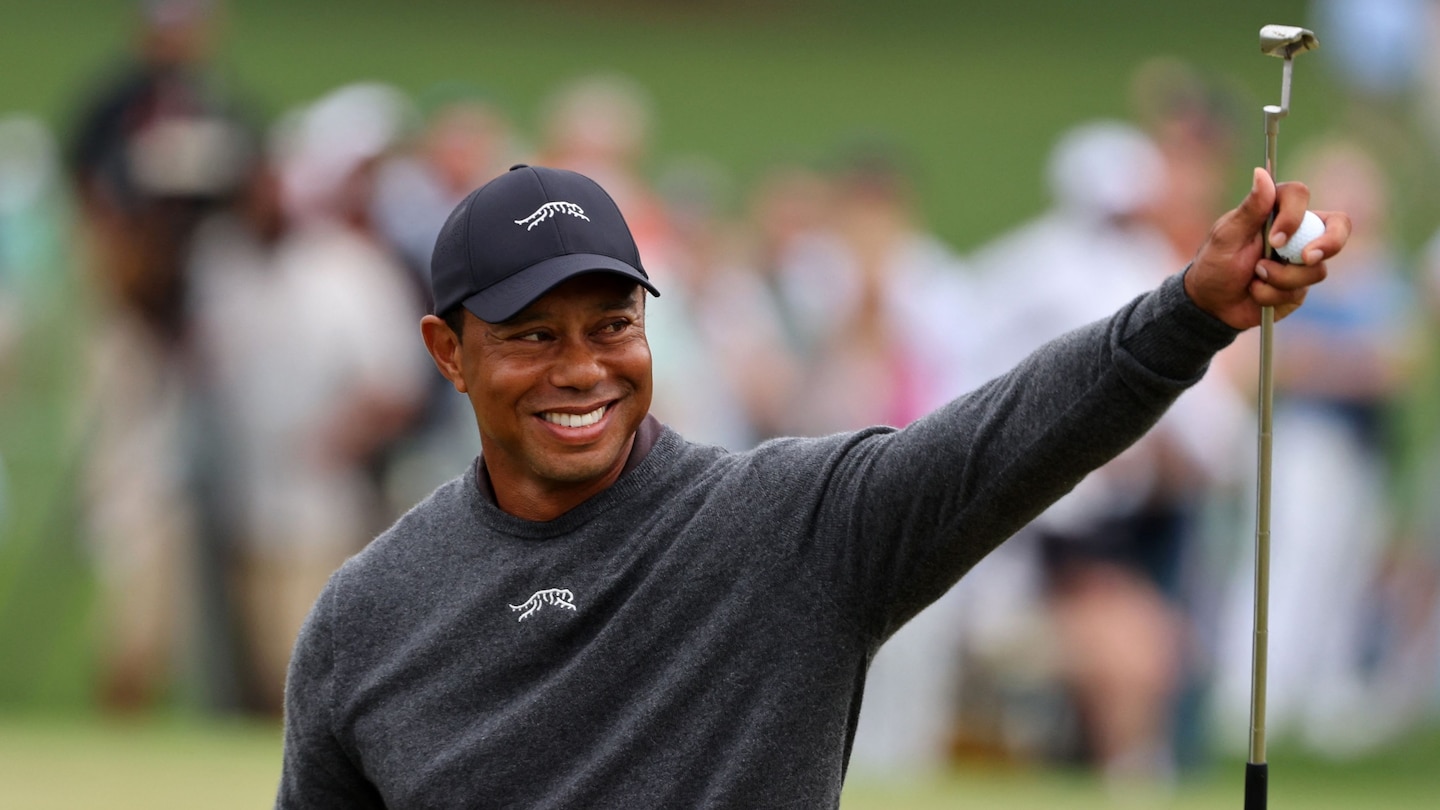Woods ripped at an iron. His ball landed on the green. Applause rippled through the pines.
And then came the important part: the walk.
“I hurt every day,” Woods said.
Woods begins his 26th Masters on Thursday stuck in a bit of purgatory between competitor and curiosity. He remains any tournament’s most significant draw even as his number of known surgical procedures (10) grows ever closer to his major championship total (15). He is 48, but when the weather chills and his body stiffens — what with his surgically fused right ankle, his right leg held together with a rod and screws, his back that has been cut into five times — he moves not like the athlete who redefined what a golfer should look like and what a golfer could do but like an aging dad who just needs to take a load off.
So even as he says, as he did Tuesday, that golf has “been my life,” there is less golf in his life than ever before and no way to know whether it can be restored.
“My practice sessions certainly aren’t what they used to be,” Woods said. “I used to live on the range or live on a short-game facility and be out there all day. That’s no longer the case. So I just have to be more focused on when I do get a chance to go out there and practice and really grind it out and make every shot count because I just really don’t have the ball count in me anymore.”
Which makes it fair to wonder whether he has wins in him anymore. Wait. Wins? How about the simple ability to endure 72 holes over four days? Some in the throngs who will follow Woods this week would call that a vacation. For him, it’s obvious labor.
“I ache every day,” Woods said.
There are competitive and personal ramifications to that. In the two years since the 2022 Masters — his first tournament after the horrific car crash that nearly destroyed his leg and worse — he has teed it up in just six official tournaments worldwide. Various ailments have caused him to withdraw from three of them, including last year’s Masters. He missed the cut in another, tied for 45th in one more and in December finished 18th in the 20-man field of the event he hosts in the Bahamas.
That’s not the résumé of a contender in this event, which he has won five times. That’s a part-time golfer with scant evidence that he can reach the weekend — here or anywhere else.
Still, failing to do so would be news this week. To this point, Woods has played 23 Masters as a pro, dating from his seminal victory in 1997. He has made the cut each time, tying Couples and Gary Player for the most consecutive cuts made here. Make it to Saturday this week, and he has yet another record. These things matter to him.
“It’s consistency,” Woods said. “It’s longevity. And it’s an understanding of how to play this golf course.”
He was talking about the shots. But understanding the course here also means understanding the walk. As brilliant as the high-definition broadcast of this event is — and it’s downright beautiful and captivating — there is no way it can capture the elevation changes in Augusta National’s terrain. That walk down from the fourth tee? It merely precedes the walk back up to get to the green. And it doesn’t compare to the stroll down the mountain from, say, the sixth tee to the green there or the absolute cliff that descends from the 10th tee to the fairway below. Woods said he has logged more than 6½ miles playing a single round at Augusta. What can’t be quantified is the toll all those ups and downs, all those uneven steps, take on a body that begins every day broken in the first place.
“We’re playing on a hillside,” Woods said, “and we’re just meandering back and forth across that hillside. So, yeah, it’s a long walk.”
Which makes his strides between shots as important to his ability to make the weekend — and then play on the weekend, which he couldn’t do in the rain and chill last year — as his ability to hit those shots. About the latter: All these surgeries and procedures and calamities later, there’s no question he can still execute golf shots.
“I don’t stare at his gait much,” Couples said. “But he just hits it so good.”
On his final hole Tuesday morning, Woods’s tee shot hit a tree, so he had a longer-than-usual approach into the ninth green. Couples watched him lash at the ball and said immediately, “Good swing.” But the next level lie in a fairway at Augusta will be the first. The ball had been below Woods’s feet. He mis-hit it only slightly, and it trickled off the front of the green and back down the hill.
Woods looked across at Couples and said, “The lie.”
“So I know the deal,” Couples said. “… It’s just hard. He said his back is doing okay. I think last year it was so bad that a lot of things just wore him down. … But this year he looks strong and he’s excited to play, and I think he looks really, really good.”
So you’re saying there’s a chance?
That’s the thing with Woods. He went more than a decade between major championships — a decade that included most of the surgeries that make him part man, part machine — and won his 15th in 2019, by which point it was reasonable to wonder whether he would or could. He is, all these years later, still defined as much by his athletic arrogance and defiance as he is by his accomplishments.
So he can sit behind a microphone and tick off the limitations he faces — and they are legion — and in the next breath express, in a mixture of hope and confidence, his belief that a win is still possible. “I still think that I can,” he said. He can reminisce about watching Sam Snead, Gene Sarazen and Byron Nelson hit ceremonial tee shots in 1995 and respond with absolute indignation when asked if he had envisioned the same for himself.
“No,” he said sharply. “I have not thought about being a starter here. No.”
He is in the field because he has earned the right for the rest of his life. More than that, he is in the field because he feels like he has a chance. The recent results say Tiger Woods — and his ravaged body — shouldn’t be considered a contender here. But if Woods has taught us anything over nearly three decades as his sport’s most important figure, it’s that his participation in a tournament reflects his intention to win, regardless of what his body and his history are telling him.


 Best Underground Water Leak Detection Equipment 2024
Best Underground Water Leak Detection Equipment 2024  Best Backyard Ideas: Turn Your Outdoor Area Into a Creative and Calm Haven
Best Backyard Ideas: Turn Your Outdoor Area Into a Creative and Calm Haven  Babar, Rizwan are good players but not whole team, says Mohammad Hafeez
Babar, Rizwan are good players but not whole team, says Mohammad Hafeez  Pak vs NZ: Green Shirts aim to bounce back against Kiwis today
Pak vs NZ: Green Shirts aim to bounce back against Kiwis today